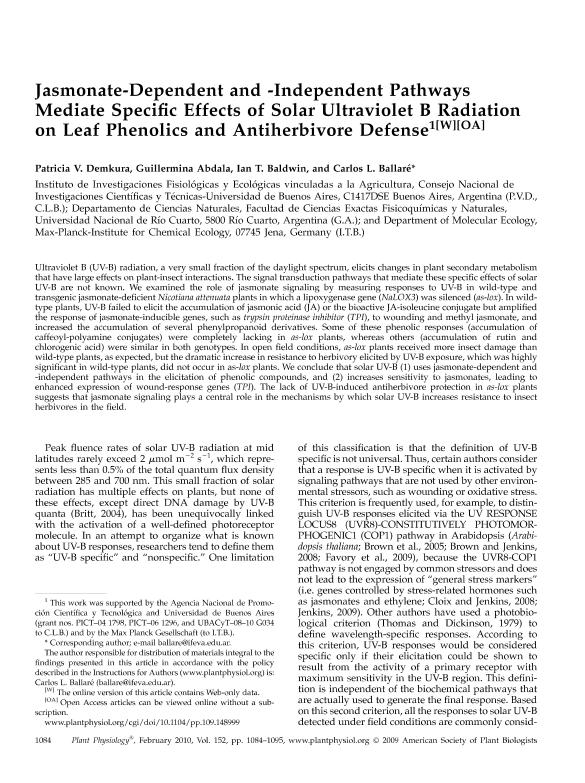Mostrar el registro sencillo del ítem
dc.contributor.author
Demkura, Patricia Vérónica

dc.contributor.author
Abdala, Guillermina Irene

dc.contributor.author
Baldwin, Ian T.
dc.contributor.author
Ballare, Carlos Luis

dc.date.available
2019-03-22T17:16:02Z
dc.date.issued
2010-02
dc.identifier.citation
Demkura, Patricia Vérónica; Abdala, Guillermina Irene; Baldwin, Ian T.; Ballare, Carlos Luis; Jasmonate-dependent and -independent pathways mediate specific effects of solar ultraviolet B radiation on leaf phenolics and antiherbivore defense; American Society of Plant Biologist; Plant Physiology; 152; 2; 2-2010; 1084-1095
dc.identifier.issn
0032-0889
dc.identifier.uri
http://hdl.handle.net/11336/72307
dc.description.abstract
Ultraviolet B (UV-B) radiation, a very small fraction of the daylight spectrum, elicits changes in plant secondary metabolism that have large effects on plant-insect interactions. The signal transduction pathways that mediate these specific effects of solar UV-B are not known. We examined the role of jasmonate signaling by measuring responses to UV-B in wild-type and transgenic jasmonate-deficient Nicotiana attenuata plants in which a lipoxygenase gene (NaLOX3) was silenced (as-lox). In wild-type plants, UV-B failed to elicit the accumulation of jasmonic acid (JA) or the bioactive JA-isoleucine conjugate but amplified the response of jasmonate-inducible genes, such as trypsin proteinase inhibitor (TPI), to wounding and methyl jasmonate, and increased the accumulation of several phenylpropanoid derivatives. Some of these phenolic responses (accumulation of caffeoyl-polyamine conjugates) were completely lacking in as-lox plants, whereas others (accumulation of rutin and chlorogenic acid) were similar in both genotypes. In open field conditions, as-lox plants received more insect damage than wild-type plants, as expected, but the dramatic increase in resistance to herbivory elicited by UV-B exposure, which was highly significant in wild-type plants, did not occur in as-lox plants. We conclude that solar UV-B (1) uses jasmonate-dependent and -independent pathways in the elicitation of phenolic compounds, and (2) increases sensitivity to jasmonates, leading to enhanced expression of wound-response genes (TPI). The lack of UV-B-induced antiherbivore protection in as-lox plants suggests that jasmonate signaling plays a central role in the mechanisms by which solar UV-B increases resistance to insect herbivores in the field. © 2009 American Society of Plant Biologists.
dc.format
application/pdf
dc.language.iso
eng
dc.publisher
American Society of Plant Biologist

dc.rights
info:eu-repo/semantics/openAccess
dc.rights.uri
https://creativecommons.org/licenses/by-nc-sa/2.5/ar/
dc.subject
Uv
dc.subject
Phenolics
dc.subject
Jasmonate
dc.subject.classification
Otras Ciencias Biológicas

dc.subject.classification
Ciencias Biológicas

dc.subject.classification
CIENCIAS NATURALES Y EXACTAS

dc.title
Jasmonate-dependent and -independent pathways mediate specific effects of solar ultraviolet B radiation on leaf phenolics and antiherbivore defense
dc.type
info:eu-repo/semantics/article
dc.type
info:ar-repo/semantics/artículo
dc.type
info:eu-repo/semantics/publishedVersion
dc.date.updated
2019-03-08T20:20:31Z
dc.journal.volume
152
dc.journal.number
2
dc.journal.pagination
1084-1095
dc.journal.pais
Estados Unidos

dc.journal.ciudad
Rockville
dc.description.fil
Fil: Demkura, Patricia Vérónica. Consejo Nacional de Investigaciones Científicas y Técnicas. Oficina de Coordinación Administrativa Parque Centenario. Instituto de Investigaciones Fisiológicas y Ecológicas Vinculadas a la Agricultura. Universidad de Buenos Aires. Facultad de Agronomía; Argentina
dc.description.fil
Fil: Abdala, Guillermina Irene. Consejo Nacional de Investigaciones Científicas y Técnicas; Argentina. Universidad Nacional de Río Cuarto. Facultad de Ciencias Exactas Fisicoquímicas y Naturales; Argentina
dc.description.fil
Fil: Baldwin, Ian T.. Max-Planck-Institute for Chemical Ecology; Alemania
dc.description.fil
Fil: Ballare, Carlos Luis. Consejo Nacional de Investigaciones Científicas y Técnicas. Oficina de Coordinación Administrativa Parque Centenario. Instituto de Investigaciones Fisiológicas y Ecológicas Vinculadas a la Agricultura. Universidad de Buenos Aires. Facultad de Agronomía; Argentina
dc.journal.title
Plant Physiology

dc.relation.alternativeid
info:eu-repo/semantics/altIdentifier/doi/https://dx.doi.org/10.1104/pp.109.148999
dc.relation.alternativeid
info:eu-repo/semantics/altIdentifier/url/http://www.plantphysiol.org/content/152/2/1084
Archivos asociados
